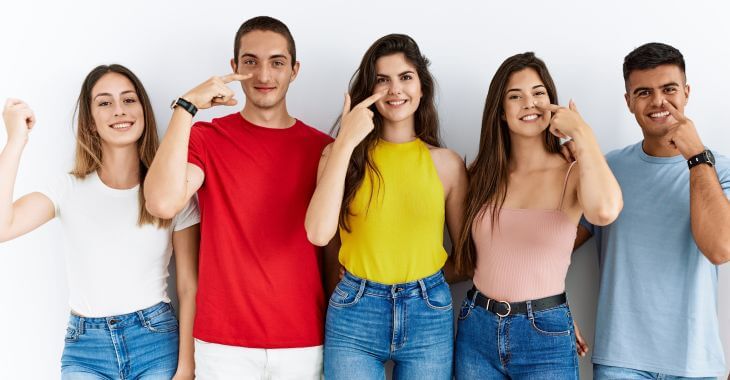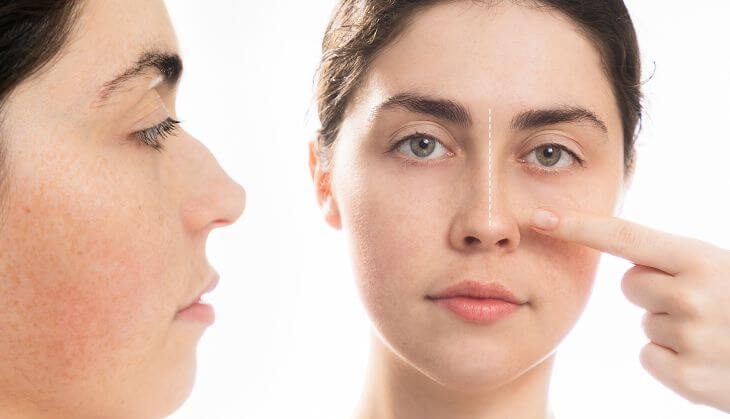Different Types of Noses

Exploring the diversity of human anatomy, the nose stands as a prominent feature that varies significantly in shape, size, and structure across individuals. The different types of noses reflect unique characteristics influenced by genetics, ethnic backgrounds, and gender.
Not only does it contribute to facial aesthetics, but the nose shape and type also play a vital role in respiratory function and olfactory perception. For many people, changing their nose shape can have both aesthetic and functional benefits.
Ethnic Influence on Nose Type
Types of noses are often linked to specific ethnicities. When looking at types of noses, female and male noses are influenced by ethnicity. The following are some of the stereotypes linking noses and ethnicity:
- Greek Nose: Often referred to as the “straight” or “classical” nose, the Greek nose is characterized by a straight and narrow bridge with a well-defined tip. This nose shape is associated with harmony and balance, admired for its balanced proportions and symmetry.
- Roman Nose: The Roman nose, also known as the “aquiline” or “hooked” nose, features a prominent and slightly curved bridge, creating a distinct, prominent profile. This nose type is historically associated with strength, leadership, and authority, often depicted in classical art and literature.
- Nubian Nose: Common among individuals of African descent, the Nubian nose is characterized by its broad base, wider nostrils, and a less defined bridge. It often features a rounded or wider tip, reflecting a distinctive and beautiful variation in nasal shape.
- East Asian Nose: Typically, noses in East Asian populations tend to have a lower bridge and a wider base. The profile often displays a lower nasal bridge, creating a less pronounced angle between the forehead and the nose.
- Jewish Nose: The term “Jewish nose” is a stereotype that refers to a larger or more prominent nose with a pronounced bridge and a slightly bulbous tip. It’s important to note that such descriptions are based on cultural stereotypes and not on any scientific or genetic reality.
- Caucasian Nose: The Caucasian nose encompasses a wide range of variations. It often exhibits a higher, narrower bridge compared to some other ethnicities, with varied tip shapes and sizes.
- Snub Nose: The snub nose, also referred to as a “button” nose, is characterized by its short and small appearance. It has a slightly upturned tip, giving it a cute and youthful look. This nose type is often found in various ethnicities and is considered endearing.
- Hawk Nose: Resembling the beak of a hawk, the hawk nose features a prominent bridge that curves down toward the tip. It’s known for its distinct profile and can be found in various ethnic groups, portraying a unique and distinguished appearance.
Ethnicity does play a substantial role in nose shape, but many people have a wide variety of ethnicities in their ancestry that affect the shape of their nose.
Appreciating the diversity of noses across cultures and ethnicities highlights the beauty of human variation. While certain nose shapes may be associated with cultural ideals or stereotypes, embracing the unique features of each individual’s nose contributes to celebrating human diversity.
Different Nose Shapes
Genetics and ethnicity are not the only factors in nose shape. Lifestyle factors, injuries and disease can also play roles in the shape of the nose. Some different nose shapes that are not usually congenital include:
- Over-rotated tip: Often called a “pig nose,” an over-rotated tip can create an upturned nose that exposes the nostrils. This can be caused by damage to the bridge from injury or cosmetic surgery.
- Saddle-nose deformity: If the nose bridge collapses, it can create a sunken bridge that has the appearance or shape of a saddle. It is also called “boxer nose” since it is common amongst boxers with damage to their nasal bridge.
- Crooked nose: Injuries to the nose can cause a crooked bridge. This can also be caused by a deviated septum.
Abnormal nose shapes do not only affect the nose appearance, but they also often impact breathing. The change in the nose shape can obstruct the nasal passages and limit respiratory function.
Nasal diversity extends beyond these categories, and each nose type can further vary in subtle nuances and characteristics within different populations. Factors such as climate, environment and genetic inheritance contribute to the array of nose shapes observed worldwide.
Changing Types of Noses
Rhinoplasty or nose reshaping is one of the most requested plastic surgery procedures. Whether someone is born with a nose they do not like, or other factors change their nose shape, cosmetic surgery can be an option for changing the shape of the nose and improving nose function.
Rhinoplasty can be performed to alter ethnic factors to achieve a different nose shape. The “nose job” is also used to change saddle nose deformities, over-rotated tips, crooked noses and other common nose shapes. It can also be combined with septoplasty to overcome nasal obstructions.

There are many different types of noses that impact the form and function of the face. If the type of nose you have is impacting your confidence or nasal function, it is worthwhile to seek a consultation with a specialist to determine if changing your nose type is right for you.
The information provided on this website, including text, graphics, images, and other materials, is intended solely for informational purposes and should not be used as a substitute for professional medical advice, diagnosis, or treatment.

)